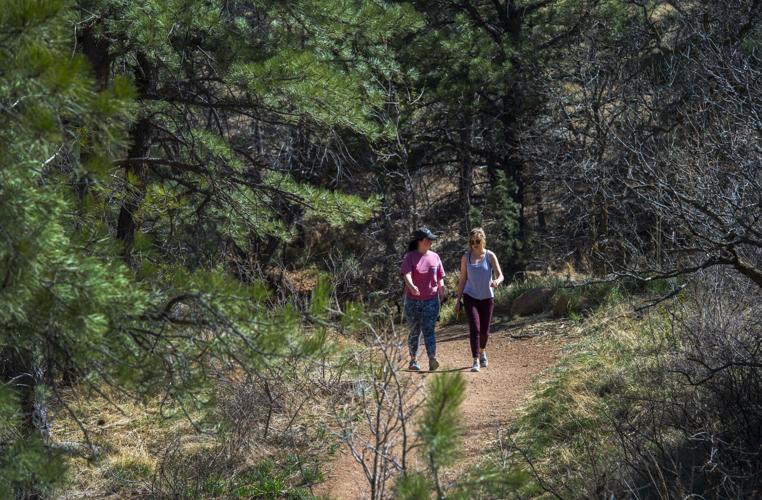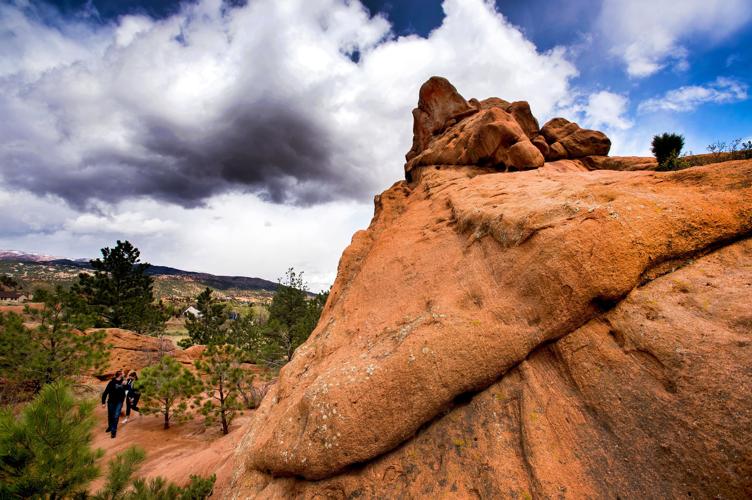Editor's note: This article has been updated to correct references to pronghorn.
Whether you want to run your dog to the Stratton Open Space reservoir, photograph pronghorn near the Colorado Springs Airport or push your child on a swing at your neighborhood playground, you probably have TOPS to thank.
When voters approved the Trails, Open Space and Parks program 20 years ago this month, they couldn't have foreseen all the benefits to be produced by that one-penny tax per $10 purchase.
City officials point to nearly 50 miles of trails, more than 4,700 acres of open space and 37 park projects when tallying the benefits to date.
Those numbers don't include essential intangibles, though. Maintenance and stewardship of all those trails and natural settings also spring from TOPS, which voters renewed by a landslide in 2003.
The program will continue until at least 2025. Its current formula calls for 3 percent to be spent on administering the program, 6 percent on maintenance of any TOPS property, at least 60 percent on open space acquisitions, and no more than 20 percent on trails and 20 percent or less for parks.
Backers of the program persisted even after the first vote failed in November 1995.
Lee Milner figured if uber-conservative Douglas County could pass such a measure, so could Colorado Springs. Then-city Councilman John Hazlehurst was behind him all the way.
Richard Skorman, now council president, pushed hard for the ballot proposal, as did Annie Oatman-Gardner, Steve Harris, John Weiss and Dan Cleveland.
Then parks chief Paul Butcher and Terry Putman, who managed planning, development and TOPS for the city, were pivotal to the program's success.
So was Chris Lieber, who ran the program for the city for many years before leaving to join N.E.S. Inc. landscape architects last December.
"Our community cares so much about outdoor spaces. It's been that way a long time. It's a big part of who we are and what we take pride in," Lieber said last week.
Cleveland was head of the Pikes Peak Area Trails Coalition at the time, a group that had a staff, a board and plenty of members to fundraise and promote the proposal.
Lieber and Kent Obee also were imperative to the 2003 program renewal.
"Of all the things going on in the city, this is a true success story," Cleveland said. "Back in the '80s and early '90s, there really was no money for these projects. It was this giant team effort. This gave us seed money to get grants, to buy property, to build trails.
"When we did Red Rock Canyon, we took thousands of people through to see how great it would be. It was getting community to work together."
Putman remembers how city parks staff "basically created the program from the bottom up," writing bylaws, creating the TOPS Working Committee and relying on the city's master plans for parks, trails and open space as their guiding documents.
The TOPS tax had been bringing in $5 million to $6 million a year until recently; next year it's expected to produce just under $8.5 million, said Milner, a member of the TOPS Working Committee.
But that's only a fraction of the money spent.
"We got lots of grants from Great Outdoors Colorado, state Parks, land donations," Putman said. "In 2002, we had spent $23 million and leveraged $17 million. We almost doubled our money. By having TOPS money as a match ... High Chaparral Open Space got a $1 million donation from the landowner. They're still getting state trail grants. Venezia Park just got another grant. That helps the money go even (further)."
"In most cases," Lieber said, "the TOPS program has been successful because it's worked with property owners and been patient. ... A lot of good things are done over time."
The program also isn't intended to stop development; its mission is to preserve special places and offer fair market value to the landowners. "I think it's one of the things that has set this program apart and made it successful in Colorado Springs," Lieber said.
Putman said he and Lieber approached Colorado parks officials to help create Cheyenne Mountain State Park, with the state paying for most of the purchase and continuing to operate and maintain the park.
Harris, an attorney, gets credit for the TOPS purchase of Bluestem Prairie Open Space, a 650-acre swath just south of the airport.
It's home to the pronghorn often seen at the airport as well as burrowing owls and black-tailed prairie dogs. And it is a vast preserve of native prairie buffalo and blue gramma grasses.
Milner is the man people point to for saving Corral Bluffs, where ranchers for decades stopped to corral cattle they were driving from Texas to Denver.
The site is rich in archaeological findings, including bison bones and stone tools, as well as rare paleontology findings.
Corral Bluffs has one of the three best exposures of the Cretaceous-Tertiary (K-T) boundary, which coincides with the extinction of dinosaurs, reports Kirk Johnson, now head of the Smithsonian Institution National Museum of Natural History and former chief curator at the Denver Museum of Nature and Science.
It's also important for having some of the most extensive surface exposures and badland outcrops in the Denver Basin.
The site remains closed to the public while the city works to determine how best to protect its rich archaeological and paleontological features.
TOPS leaders - from the program's city administrators to the TOPS Working Committee, Park Advisory Board and ultimately City Council - now are pursuing acquisition of several thousand acres to link Corral Bluffs with Jimmy Camp Creek Park, neither of which is open, plus trails down forks of Jimmy Camp Creek.
Also being studied are acquistions of as much of the mountain backdrop as possible, land at the confluence of West Sand Creek and Sand Creek and more property for Cheyenne Mountain State Park.
Yet to date, the favorite TOPS project among most of the program's founders - and the biggest and most difficult to acquire and prepare - remains Red Rock Canyon Open Space.
People flock to the site today with dogs and mountain bikes, filling the sizable parking lots every weekend. Twenty years ago, few would have ventured into the 789-acre canyon.
Owner John Bock was known to blast his shotgun at intruders, and the site was littered with a trailer park, a 53-acre landfill that operated from 1970 to 1987, foundations of old factories, and remains of quarries that hauled away a lot of the 320 million-year-old red sandstone.
Bock had elaborate plans to build a resort there, and not until he died could TOPS buy the land from his widow, Joan.
"It was No. 8 on the priority list because of the environmental contamination, quarry, unwilling seller," Skorman said. "I remember we had to argue at a meeting (to buy it)."
But the city paid $12.5 million for Red Rock Canyon in 2003 and began the massive cleanup and master plan for the site.
"We had to relocate the residents and do an in-depth environmental study of the property and a lot of exercises to get it where it is today," Putman said. "We used the Trust for Public Lands to negotiate the purchase. It was quite a job."
Was it worth it? "If all we could do was to purchase Red Rock," Milner said, "TOPS would have been a success."
Even Lieber, who takes great pride in the many neighborhood parks created through the TOPS program, says Red Rock Canyon is his favorite.
"It's become such a part of the community," he said. "My daughter and her friends don't remember a time without Red Rock Canyon."













 Your Privacy Choices
Your Privacy Choices